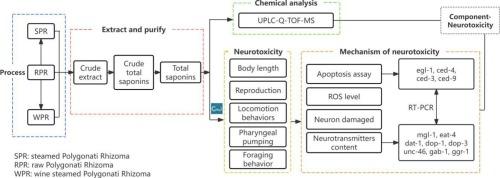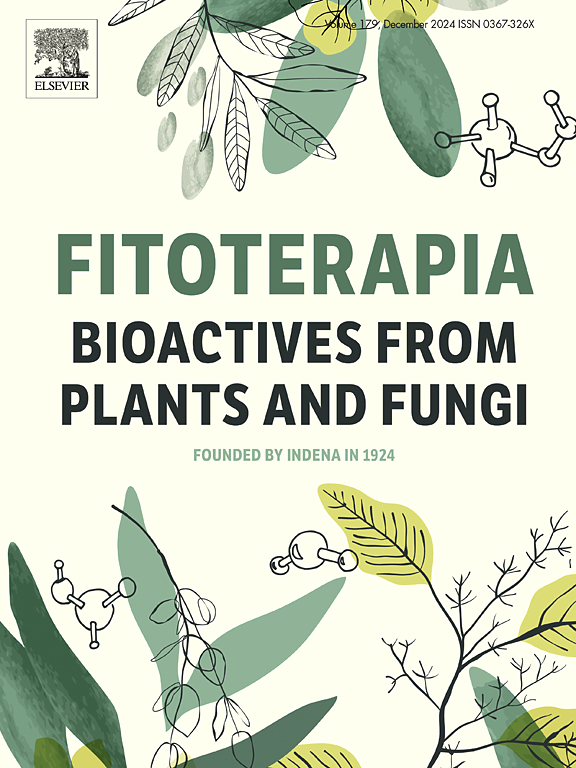The analysis of raw and processed Polygonatum kingianum saponins and stimulatory mechanism in Caenorhabditis elegans
IF 2.5
3区 医学
Q3 CHEMISTRY, MEDICINAL
引用次数: 0
Abstract
Polygonati Rhizoma, a Chinese medicine often used in the clinic, can irritate the tongue and throat, so it must be processed before use. Polygonati Rhizoma contains a variety of chemical components, with saponins being one of the main active ingredients. Saponins can be highly irritating to human mocous membranes and have toxicity. In this study, total saponins were extracted from raw and processed Polygonati Rhizoma and detected by UPLC-Q-TOF-MS to identify their constituents. A total of 46 saponins were detected in TSRPR(total saponins of raw Polygonati Rhizoma), TSSPR(total saponins of steamed Polygonati Rhizoma) and TSWPR(total saponins of Polygonati Rhizoma steamed in wine). Of these, 9 compounds that were present in TSRPR were not detected in TSSPR and TSWPR. C.elegans was used as a model animal to study the neurotoxic effect and its mechanisms. TSRPR was found to have neurotoxic effects on C.elegans, but TSSPR and TSWPR had no adverse effects on the nematodes. The disappearance of the irritant effect of raw Polygonati Rhizoma after processing might be related to the changes in the composition of saponins, and the main reason might be the structural transformation of saponins. In particular, the sugar chains of some highly irritating saponins may have been removed or highly irritating saponins isomerized into weakly irritating saponins. The mechanisms of neurotoxic effects on C.elegans may include upregulation of ced-3 and egl-1 expression to promote apoptosis, damage to GABAergic and cholinergic neurons, downregulation of the GABA transmitter receptor genes ggr-1 and gab-1, and a decrease in glutamate levels that impairs nerve signal transmission.

分析生何首乌皂甙和加工何首乌皂甙对秀丽隐杆线虫的刺激机制
何首乌是临床常用的中药,会刺激舌头和咽喉,因此使用前必须加工。何首乌含有多种化学成分,其中皂甙是主要活性成分之一。皂苷对人的口腔黏膜有很强的刺激性,并具有毒性。本研究从未加工和加工过的黄精中提取了总皂苷,并通过 UPLC-Q-TOF-MS 进行检测,以确定其中的成分。在 TSRPR(生何首乌总皂苷)、TSSPR(蒸何首乌总皂苷)和 TSWPR(酒蒸何首乌总皂苷)中共检测到 46 种皂苷。其中,TSRPR 中的 9 种化合物在 TSSPR 和 TSWPR 中均未检测到。研究人员使用秀丽隐杆线虫作为模型动物,研究其神经毒性作用及其机制。结果发现,TSRPR 对线虫有神经毒性作用,但 TSSPR 和 TSWPR 对线虫没有不良影响。加工后的生何首乌刺激作用消失可能与皂苷成分的变化有关,主要原因可能是皂苷的结构转变。特别是一些高刺激性皂苷的糖链可能已被去除,或高刺激性皂苷异构化为弱刺激性皂苷。对秀丽隐杆线虫的神经毒性作用机制可能包括上调 ced-3 和 egl-1 的表达以促进细胞凋亡、损伤 GABA 能神经元和胆碱能神经元、下调 GABA 递质受体基因 ggr-1 和 gab-1,以及降低谷氨酸水平以损害神经信号传递。
本文章由计算机程序翻译,如有差异,请以英文原文为准。
求助全文
约1分钟内获得全文
求助全文
来源期刊

Fitoterapia
医学-药学
CiteScore
5.80
自引率
2.90%
发文量
198
审稿时长
1.5 months
期刊介绍:
Fitoterapia is a Journal dedicated to medicinal plants and to bioactive natural products of plant origin. It publishes original contributions in seven major areas:
1. Characterization of active ingredients of medicinal plants
2. Development of standardization method for bioactive plant extracts and natural products
3. Identification of bioactivity in plant extracts
4. Identification of targets and mechanism of activity of plant extracts
5. Production and genomic characterization of medicinal plants biomass
6. Chemistry and biochemistry of bioactive natural products of plant origin
7. Critical reviews of the historical, clinical and legal status of medicinal plants, and accounts on topical issues.
 求助内容:
求助内容: 应助结果提醒方式:
应助结果提醒方式:


